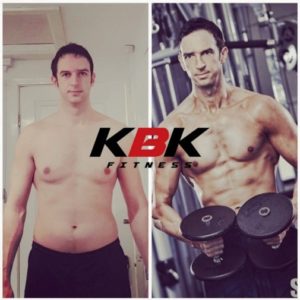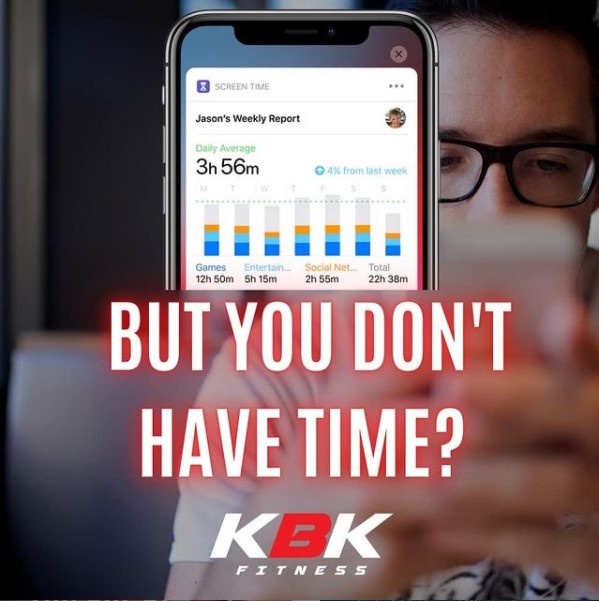In this issue
Editor’s Corner. Mailbag. Want to get fit and healthy but just can’t find the time? Treat yourself! ROM and TUT. Chunky Aerobics Instructor Syndrome. Prepare yourself to be a rubber-band (wo)man. ITpro Toolbox.

We’re smart enough to stay indoors when there’s extreme weather, so why do we sometimes go extreme with our fitness and nutrition? Photo by NOAA on Unsplash.
Editor’s Corner

Mitch Tulloch is the Senior Editor of FitITproNews and a recovering fat IT pro who lost 50 lbs in midlife and is now on his way to becoming a fit IT pro. Mitch is a widely recognized expert on Windows Server and cloud technologies who has authored or been Series Editor of numerous books/ebooks from Microsoft Press. Mitch is also the Senior Editor of WServerNews and writes frequently for TechGenix.
Hey everyone! Welcome to the June 2021 issue of FitITproNews, the world’s only newsletter devoted to helping “recovering fat IT pros” make progress on the journey towards strength and health! In this issue we hear from Kris Kane about how spending too much time on your phone can sabotage your health and fitness goals. Next up is Sarah Trammell who explains how you can incorporate treats into your diet in a way that won’t do too much damage to your caloric intake. Robin Camp then takes us into the world of resistance training acronyms by encouraging us to use ROM and TUT in our weightlifting workouts. Then our own Lana Khazari shares how making “less is more” your mantra can improve your health and fitness. And finally Kris Lall shares the secret of how to avoid getting pulled muscles and torn ligaments.
Now for my thoughts on a subject that’s been brewing on my mind for a while. Back in our September 2020 newsletter I was struck by something columnist Kris Lall touched upon in his article titled “Take it easy!” where he talked about Jim Fixx who became famous in the 70’s when he quit smoking, lost 60 pounds and took up jogging which later resulted in his classic book “The Complete Book of Running” which reached number one on bestselling book lists. Jim was instrumental in kickstarting the fitness revolution and all of us “recovering fat IT pros” owe him a huge debt for this, but unfortunately he couldn’t collect on this debt because he experienced a sudden heart attack while jogging and died at the relatively young age of 53.
This got me thinking about the wisdom — or lack of it — in going too extreme with our exercising, nutrition or sports activities. During the last dozen years since I lost 55 lbs and began exercising and eating properly, I’ve sought out advice, wisdom and motivation from a variety of sources such as fitness magazines, nutrition websites, and books and articles by various health and fitness icons. Some of the people who have influenced me by either helping me make progress or keeping me from quitting have included Greg Plitt, Charles Poliquin, Dolph Lundgren and many others. And while the teachings and experiences of these iconic individuals can be helpful for fat IT pros like me who want to turn their life around, their lives can also serve as warnings for us not to go too extreme.
Jim Fixx is perhaps the classic example. When he started running at age 35 he weighed 214 lbs and smoked two packs of cigarettes per day. Ten years later when his book was published he was 60 lbs lighter and no longer smoked. Seven years after that he was dead from a heart attack. The lesson here is that the damage to his arteries was probably already done by the bad habits of his early years, and that recovering fat IT pros like ourselves should set realistic limits to the amount of exercise we can safely expect to do.
Greg Plitt is another interesting example of someone who took fitness to the extreme. Plitt served in the US Army as a Ranger and later became a certified fitness trainer and appeared everywhere on fitness magazines and websites showing his awesome abs. Then at the very young age of 37 while recording video for a fitness commercial in an industrial area where trains were running, he was hit by a train and killed while running between the rails. TMZ reported that police felt Plitt may have been trying to outrun the train. Faster than a bullet and more powerful than a speeding locomotive? No, even if we lose enough weight to display abs of steel, we’re all still made of clay and should avoid such extremes.
Charles Poliquin was a highly respected Canadian strength coach whose articles on weightlifting and nutrition I used to consume regularly and learned a lot from. Poliquin took a scientific approach to strength training and conditioning, and his book The Poliquin Principles is well-researched and valuable especially for individuals in sports where a high degree of strength and conditioning is required. He died at the age of 57 for reasons that are unclear. One close friend told The Toronto Star that Poliquin was aware that heart disease was in his family (his dad had died from it) and as a result he always tried to stay on top of his nutrition at all times. However I recall reading an interview with him in a fitness magazine about ten years ago during which he showed the interviewer the contents of his refrigerator. Inside his fridge was a dozen or so whole cooked chickens, and if I recall correctly Poliquin told the interviewer that he ate several of them each day in order to get enough protein for his strength training routines. Now if that story is true (as I remember it) then I would hesitate to call that lifestyle one of “staying on top” of your nutrition. Extreme eating can be just as damaging as extreme exercising.
Dolph Lundgren is someone whose movies Ingrid and I enjoy a lot. Some of them are very well made (e.g. The Russian Specialist) while others are campy and fun (e.g. Agent Red) though those who are not Dolph movie completionists will probably only remember him as Ivan Drago the huge almost mechanical robot and Russian boxer in Rocky IV who told Rocky “I will break you” as they faced each other in the ring. Dolph holds a 4th degree black belt in Kyokushin karate and was European Champion in 1980 and in recent years he’s often been on the cover of magazines like Men’s Health and Muscle & Fitness. I suppose this was partly to promote his new movies, but also I suspect to send the message that even in your late 50s or early 60s you can still have a lean body that looks like it’s chiseled from stone. What may not be well know though is that just a few years ago at age 60 Dolph underwent double hip replacement surgery. Naturally this hasn’t slowed down his devotion to fitness (according to the Hollywood news media) but the reality is that hip replacement don’t make us mechanical robots. They don’t add something to our bodies, they take something away from them. And it’s something I would never want to have to undergo myself having known several individuals my age who have had them. Was his lifelong commitment to martial arts training instrumental in wearing out his hip joints? I don’t know, but I do know that our bodies will eventually wear out. And if we overdo it by exercising too much or too intensely, no matter how well we eat or supplement or how much physio therapy we undergo, we can be in danger of bending, breaking or snapping something that may never be the same afterwards whether it heals or is replaced.
So be careful, don’t go too extreme, and don’t try to become a fitness icon if you already let your body get too out of shape.
Enjoy this month’s issue of FitITproNews and feel free to send us feedback on any of the topics we’ve covered — we love hearing from our readers!
Cheers!
Mitch Tulloch, Senior Editor
Mailbag
In our previous issue Ergonomics and the IT professional I shared some of my experiences on using a standing desk. One of our readers Ted Bodfish responded to this with his own take on the subject:
Hi Mitch, I thought I’d send you my thoughts on the recent FitITproNews issue.
First, my Sit-Stand desk experience. I currently use a Sit-Stand desk which I built myself, although I must admit that it is used more as a Sit than as a Stand. The Stand position is particularly useful when I must work back-and-forth at two places in my office. It saves getting up out of the chair.
I built the desk using an IKEA L-shaped desktop and another, non-IKEA set of up-down legs. I chose to avoid the IKEA sit-stand legs because they only had a single motor. All the legs I have purchased have two motors – one for each leg. I have also installed a pull-out keyboard drawer which also has room for my mouse. All-in-all it works really well for me in both positions. I have a little timer which has two settings – one for sitting and one for standing. Saves having to nag myself about when to change things up (or down).
I have a 43″ 4K TV on an arm so it floats above the mess on my desktop. This is very useful since it is equivalent to having four 1920×1080 monitors in front of me. The 4K TV was purchased at Canadian Tire for about $375 on special in 2016. Just looked online and they have a 43″ 4K TV for $299.99! That’s cheaper than 4 1080P monitors!
As an aside, I also bought two sets of up-down legs and replaced the folding legs on two tables for my wife to use. One table has her sewing machine and the other is an 8 footer which she mainly uses for laying out and cutting fabric. She finds it very useful to raise or lower the tables to suit the various tasks she performs at those tables.
I’d also like to add a bit more to my comment about the timer. I read an article by a health professional who recommended 10 minutes standing and 30 minutes sitting. Those are the settings I have on my timer.
Ted also voiced some comments concerning Kris Lall’s article “Lead an IT pro to water” about hydration which was also in our previous issue:
Second, Kris Lall’s column about water. Several years ago I was in the habit of taking a bottle of Gatorade as part of my lunch which I ate in my office. I ditched the Gatorade and just took water for my lunch. I didn’t change any other habits and over the course of a year I dropped 20 pounds. That simple little change sure made a difference. So, like Kris, I’m drinking only water most of the time. Thanks for providing the FitITproNews!
We always welcome comments like this from our readers, so send us your feedback on anything in our newsletter!
Want to get fit and healthy but just can’t find the time? (Kris Kane)

Kris Kane is a North Yorkshire based personal trainer, martial arts instructor and general fitness enthusiast. You can find him on Instagram at @koachedbykris and also view him professionally on LinkedIn at www.linkedin.com/in/kris-kane.
Check how much you might be spending on other activities that might not be serving you so well!
People will easily spend 3-4 hours a day scrolling on their phone then say there isn’t enough time to prepare a healthy meal, do a workout or even just get out for a walk.
If you really want to live a heathier lifestyle, start making yourself a priority over what the gossips are moaning about on Facebook.

What does your average screen time say? You might be surprised!
Also I recommend this to reduce the amount of time sat down during the day, especially when working from home:
https://www.amazon.co.uk/Yo-Yo-DESK-BLACK-Height-Adjustable-workstations/dp/B01FSVNKWA/
Treat yourself! (Sarah Trammell)

Sarah Trammell is an application analyst at a university in Georgia. She became interested in health and fitness issues when she began making diet and lifestyle changes to lose weight back in 2007 and learned even more when trying to track down what to do about other health issues beginning in 2011 with not much input from doctors. You may follow her blog at ihatemyglutenfreelife.com.
Do you have a lot of favorite treats but are concerned about indulging due to consuming too many excess calories? There are ways I’ve found to incorporate treats into my diet that won’t do much, if any, damage to my caloric intake.
- Consume your favorites in small amounts. I love having a Reese’s peanut butter cup, a fun-size Snickers bar, one or two (gluten-free) cookies, and others here and there. When needed, I’ll cut down on what I have at meals to make room for such treats. Eating them in small amounts makes this much easier, and at times, I don’t even worry about cutting back and just enjoy the treats because the calorie counts are small enough.
- Consume your treats as part of a meal. I will sometimes have a candy bar with breakfast when I can make room for one. I might have one with a piece of fruit and/or with some yogurt or cottage cheese. I’ve had leftover cobbler for breakfast with sausage. I can even make something like oatmeal more of a treat by stirring in a pack of hot chocolate mix. I’ve also eaten a candy bar with a healthy microwave entree at other mealtimes.
- Consume your treats as the entire meal. I love milkshakes, but even the small sizes contain a meal’s worth of calories, so it can be difficult to indulge in one. I’ve made milkshakes at home using a nutrition shake rather than plain milk to get a broader spectrum of vitamins and minerals. I’ve made milkshakes with vanilla ice cream, a chocolate nutrition shake, frozen berries, powdered peanut butter, and a banana. Another way to indulge would be to get just the milkshake or ice cream treat when getting a fast food meal.
One thing to keep in mind when consuming treats as part of the meal or as the complete meal is to make sure you use the other meals to get enough whole plant and animal foods into your diet to meet your nutrition needs for that day. Another thing is to make this sort of indulgence just an occasional one. While it’s exciting to have a way to enjoy a favorite treat without over-consuming (or over-consuming by much) throughout the day, doing it too often may cause you to crowd out the foods that you really should be eating, like lean meats, whole fruits and vegetables, beans, nuts, seeds, whole grains, and others. Enjoy treats while getting enough of the foods that will actually help you build a healthy body.
Hopefully these tips will help you to find ways to incorporate your favorite treats into your diet without derailing your progress. Treats shouldn’t have to be given up. They should be enjoyed in moderation as part of a healthy, balanced diet.
ROM and TUT (Robin Camp)

Robin Camp works as tech support for an Orthodontic Practice Management Software company called New Horizons Software ( www.nhsoftware.com). As a professional photographer on the side, Robin does fashion, glamour weddings and more in his spare time (www.dancingwithlightphoto.com). You can also now find him working out on Instagram at https://www.instagram.com/fitittech/.
What is ROM and what does it have to do with fitness? ROM quite simply is Range Of Motion. Watch a competitive lifter lift and you will see them take advantage of the entire range of motion an exercise offers, unlike unexperienced lifter’s who may think they are strong but are only doing partial reps. Partial reps have their place in a training regimen, but they are only for overcoming a sticking point in an exercise or for simply obliterating an already tired muscle for maximum hypertrophy.
Getting back to ROM; imagine the simple task of a bench press, you press it off the rack and lower it about half way down to your chest and then press it back up. In this scenario you are still building some strength with this partial rep, but to truly build as much as possible and take full advantage of this exercise you want to bring it all the way down to your chest and press it to extension without locking your elbows. ROM is about fully utilizing as much of the target muscle group as possible, getting full contraction and extension. With a partial contraction and partial press you are only hitting part of the muscle.
TUT stands for Time Under Tension. Imagine this, you are bench pressing 135lbs for 10 reps, you knock them out as quickly as possible, your arms and the weight are a blur. Now, imagine doing the same 135lbs for 10 reps, but doing each rep in a slow, controlled manner counting to three as you lower the weight and pressing up slowly counting to three again. Here is what makes TUT interesting, you are technically lifting the same weight, the same number of times, however, the two sets are not as efficient as each other.
Why? Your muscles respond to the time under load, whether it is a press or a pull, the greater the time the muscle stays active during the rep, the more time you are utilizing to create the micro tears that create muscle growth and increased strength. Another plus side of focusing on TUT rather than knocking out reps as fast as possible is that when we slow down our movements, we tend to actually focus on the movement, getting nice clean reps in and reducing the chance of injury from a hurried workout.
Try a couple workouts and see how you feel, focusing on a full Range Of Motion and taking your time to maximize your Time Under Tension. Both may seem like negligible changes, the results however, may surprise you.
Stay safe, and have fun!
“Do not let yourself be contaminated by others’ ideas of what is best for you. Cast aside the shackles of destructive thinking.” -Kai Greene-
“If something stands between you and your success, move it. Never be denied.” -Dwayne Johnson-
“If you can’t do something smart, do something right.” -Jayne Cobb-
“Why do we fall? So we can learn to pick ourselves up.” ~Alfred Pennyworth~
Chunky Aerobics Instructor Syndrome (Lana Khazari)

Lana Khazari is a Technical Support Analyst for the Corporation of City of Windsor, Ontario, Canada. She is also a Precision Nutrition Coach, Personal Trainer, Fitness Instructor and a Yoga 200-RYT Instructor. You can find her online at lanakharazi.com.
I taught 5+ aerobic classes a week after work and on the weekends. I taught a fitness class called BodyAttack (yep, exactly as it sounds) and a core class on Monday. I taught a spin class and another BodyAttack back-to-back on Tuesdays. Saturdays, I was doubling up with BodyPump and BodyAttack. I was subbing more classes on my “off” days. For the number of fitness classes I taught, you would have thought I would be shredded. Nope. I was still chunky.
Even with a resting heart rate in the ’50s, I was proof of “Chunky Aerobics Instructor Syndrome.” Conceived by world-renowned strength coach Charles Poliquin, who noted that despite aerobic instructors teaching 5 to 8 classes per week, they had a disproportionate amount of body fat for the amount of activity performed. Some fitness instructors indeed train harder than professional athletes. I know fitness instructors who teach and train 3+ hrs per day.
At the time, I believed unless you puke, faint, or die, keep going. My “cardio” training was excessive. And as much as I wanted to shed the pounds, I just couldn’t. At that time, “cardio” was the answer, and because of it, there were other signs I chose to ignore: uncontrollable hunger, muscle weakness, mood changes, including irritability. All glaring signs that I was overdoing it. After a night of two high-intensity classes, back-to-back, wringing sweat out of my hair, I would land hard on the couch for the remainder of the evening. My husband would tell me this is not normal. Did I listen? Ummm, do we ever? I wasn’t going to listen to someone who barely stepped foot into a gym. What does he know?
The problem with steady-state cardio is the body is brilliant, and it adapts. It gets more “efficient” at using fat as a fuel source. Meaning that the more you do, the less fat you will burn. The aerobic activity equation: more = less. It’s the law of diminishing returns. Due to increased efficiency, you have to do more to burn the same amount of calories. The only option to burn more calories is to do even more, which means even longer cardio sessions. Not only is training catabolic and breaking the body down further, but too much aerobic activity increases cortisol levels and destroys muscle tissue. And if you do too much the way I did, you end up overtrained and burnt out.
Some warning signs and symptoms of overtraining and malnutrition:
- Loss of menses
- Exhaustion/fatigue
- Injuries and overuse of pain meds
- Orthorexia – continued elimination of even healthy foods
- Depressed, irritable, and anxious
- Trouble sleeping
- Often cold
- Digestion is sluggish
And why did I continue to engage in maladaptive behavior when there were other options? Because I was obsessed with losing weight and believed that this was the only way to do it. I thought traditional “cardio” (aerobic activity) was the answer to my desired physique changes. Instead, I suffered the consequences of too much.
As another real-world example, look at the number of people who have signed up for triathlons and marathons year after year. Even with large volumes of aerobic activity, these individuals’ bodies do not waste away during their efforts. Many overweight people still cross the finish line.
Now, look at a sprinter — opposite of a marathoner and mostly lean as hell. Train with strength and power as a focus and not with aerobic activities. Here we visit the flip side of the equation where less = more.
That “less is more” change in programming fixed my chunkiness. And although I didn’t train precisely like an athletic sprinter, I introduced strength into the routine and very slowly cut back on aerobics. Lifting weights helped increase my muscle mass and improve my cellular metabolism, which in turn fired up my metabolism. It was hard to give up the “endorphin-high” cardio at first. But then something magical happened, and I started seeing results. I began to trust the process, and I cut all cardio out like a bad boyfriend. And then the results came even faster. I unveiled the physique I dreamed of for years by committing to a nutrient-dense diet, four strength training sessions a week, and zero cardio. That’s right, only 4 hrs a week of training versus 10+ hrs of training aerobically. I felt like I cheated.
It did take some time because my physiological processes were in desperate need of repair. Undoing excessive exercise, the stress of a full-time job, and a part-time job learning and executing fitness class choreography, plus improper diet, wreaked havoc on my hormones. I had to resync my internal systems and course-correct my metabolic, hormonal, and internal biochemical functions.
The lesson here is that you don’t do more things to break down when your body is breaking down. Different types of exercises trigger different kinds of hormones. Hormones determine whether you use protein, fat, and energy or build proteins while using up fat and energy. Weight training helped to rebuild my metabolism, muscle, and bone. A nutrient-rich diet helped me to rebalance.
The hardest pill for me to swallow was the need to DO LESS. In terms of exercise, the temptation here was always to “do more.” If you have damaged your metabolic and hormonal regulating system because of dieting and training, it will take TIME to correct. I have learned to work “with” my body instead of working “on” my body. Ultimately, it was my choices that were responsible for the damage incurred. Experiencing the typical “endorphin high” kept me blind to the association. How can something that made me feel so good also break me down? But the truth was that I felt good during, not after. Aerobic classes were both stimulating and catabolic. One may not feel it tomorrow or the next day, but then “all of a sudden,” you have stress fractures, irritability, and other symptoms.
Receiving the correct information is necessary to buy into alternate approaches. The lesson learned here is that aerobic training is over-rated regarding health, performance, and fat loss. For fat loss and retention of lean muscle mass, weight training and interval cardio (think HITT, not aerobics) is the training to prioritize. I programmed my body to up-regulate my fat-burning hormones and speed up my metabolism. Some will embrace this lesson, and some won’t. One must understand proper and efficient training strategy and abolish the belief that traditional “cardio” is the answer to physique enhancement.
Prepare yourself to be a rubber-band (wo)man (Kris Lall)

Kris Lall works as a product manager in the tech industry for an enterprise software manufacturer. As a youngster, Kris was consumed with soccer before technology came along. Now he’s consumed with both. You can find him on Twitter at the not-too-surprising handle @krisoccer.
One of the common causes of injuries with athletes and those who work out is pulled muscles and torn ligaments or tendons. Hence, it’s no secret that experts have long recommended that athletes stretch prior to working out or participating in any sort of activity that stresses various areas of the body.
I’ve played soccer for many years and have experienced pulled muscles and torn ligaments. The worst was a groin pull that kept me off the field for more than two months. I found out the hard way that groin muscles play a very important part in lateral movement.
Hence, I’m now vigilant about stretching prior to taking part in any physical activity that requires optimal physical performance.
According to WebMD, the most common injuries that proactively stretching can help prevent include an ankle sprain, groin pull, hamstring strain, and knee injury. Further, based on my own experiences and those of former teammates, other common injuries for athletes include torn Achilles tendon, calf and quad muscle pulls, and foot/ankle ligament tears.
Common stretches athletes perform prior to taking part in physical activities include the calf muscle and Achilles tendon stretch:

and the quad muscle stretch:

Photos Copyright: Amanda Mills, USCDCP
VeryWellFit.com provides some helpful groin muscle stretches:
https://www.verywellfit.com/best-stretching-exercises-for-groin-pain-3120314
Perhaps needless to say, when you first start stretching, don’t overdo it. Start easy and stretch slightly farther each time. If you’re just beginning to exercise again and haven’t stretched in some time, your muscles, tendons, and ligaments are likely tight. Gradually work up to the point where your muscles need to be for the physical activity in which you plan to partake. Also, consult with a personal trainer if you have any concerns about stretching.
If you do strain a muscle, tendon, or ligament, give it a rest and consult with a doctor, if necessary. WebMD recommends applying ice within 48 hours of the injury (with compression) to reduce swelling. Further, my doctor has recommended taking vitamin D on a regular basis to facilitate proper healing of injuries.
Stretching requires very little time, but the payback in fewer injuries can be significant. Once you add 5, 10, or 15 minutes of stretching time to your exercise routine, it’ll become a daily or every other day habit and you’ll be much less likely to experience an injury that could keep you out of the game for an extended period. Pretty soon you’ll be as flexible as a rubber band man or woman.
References:
https://www.webmd.com/men/features/seven-most-common-sports-injuries
https://advancedtissue.com/2014/11/vitamin-d-healing-wounds/
https://www.verywellfit.com/best-stretching-exercises-for-groin-pain-3120314
Send us your feedback!
Got feedback about anything in this issue of FitITproNews? Email us today!
ITpro Toolbox
dtSearch®-Instantly Search Terabytes. Doc. filters for popular file types, emails, databases & web data; 25+ search options; Win/Lin/Mac C++/Java/.NET Core APIs; Azure/AWS FAQs. Enterprise/dev evals available.
fselect is a command-line tool to search files with SQL-like queries:
https://github.com/jhspetersson/fselect
HTTrack is an offline browser utility, allowing you to download a website from the Internet to a local directory:
https://www.httrack.com/page/2/en/index.html
PowerPlanSwitcher provides a quick UI for switching power schemas & automatic switch on AC-plug-in on Windows 10:
https://www.microsoft.com/en-us/p/powerplanswitcher/9nblggh556l3?activetab=pivot:overviewtab
